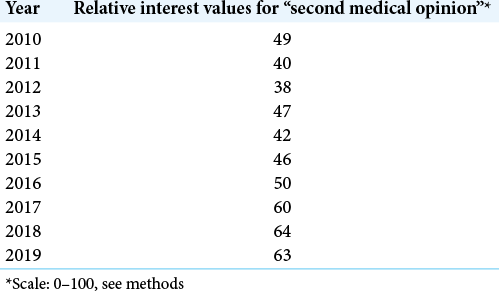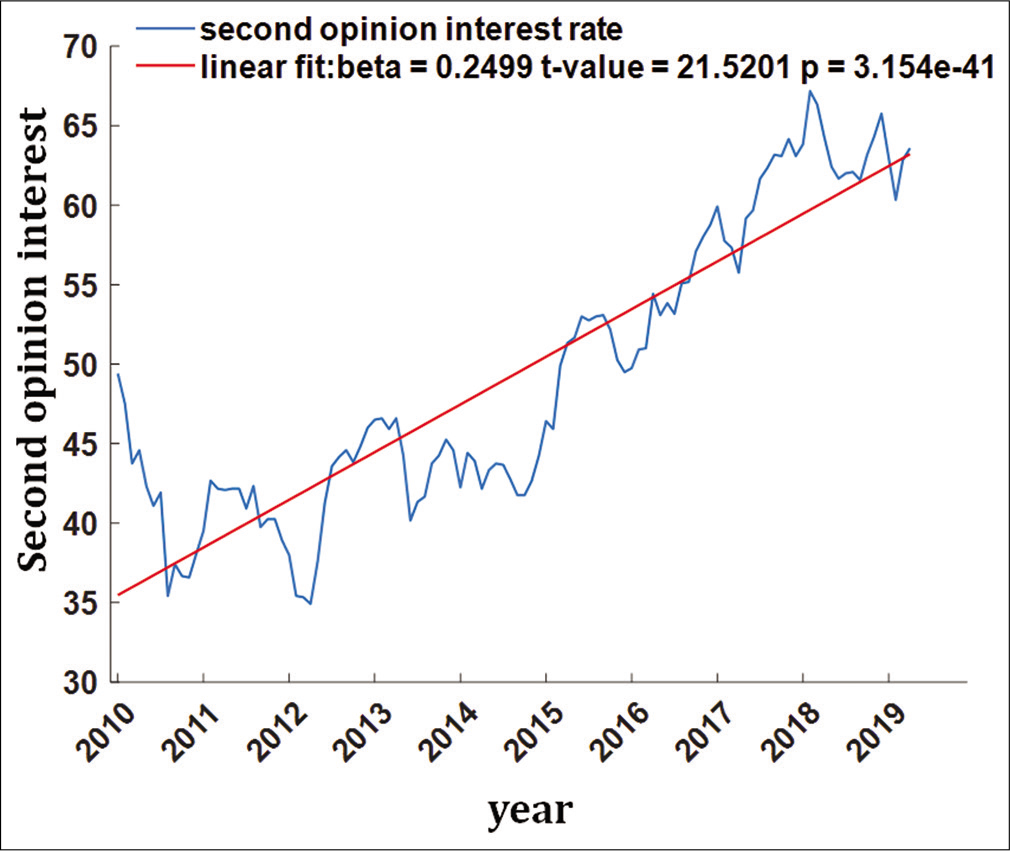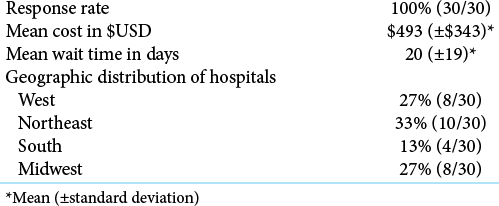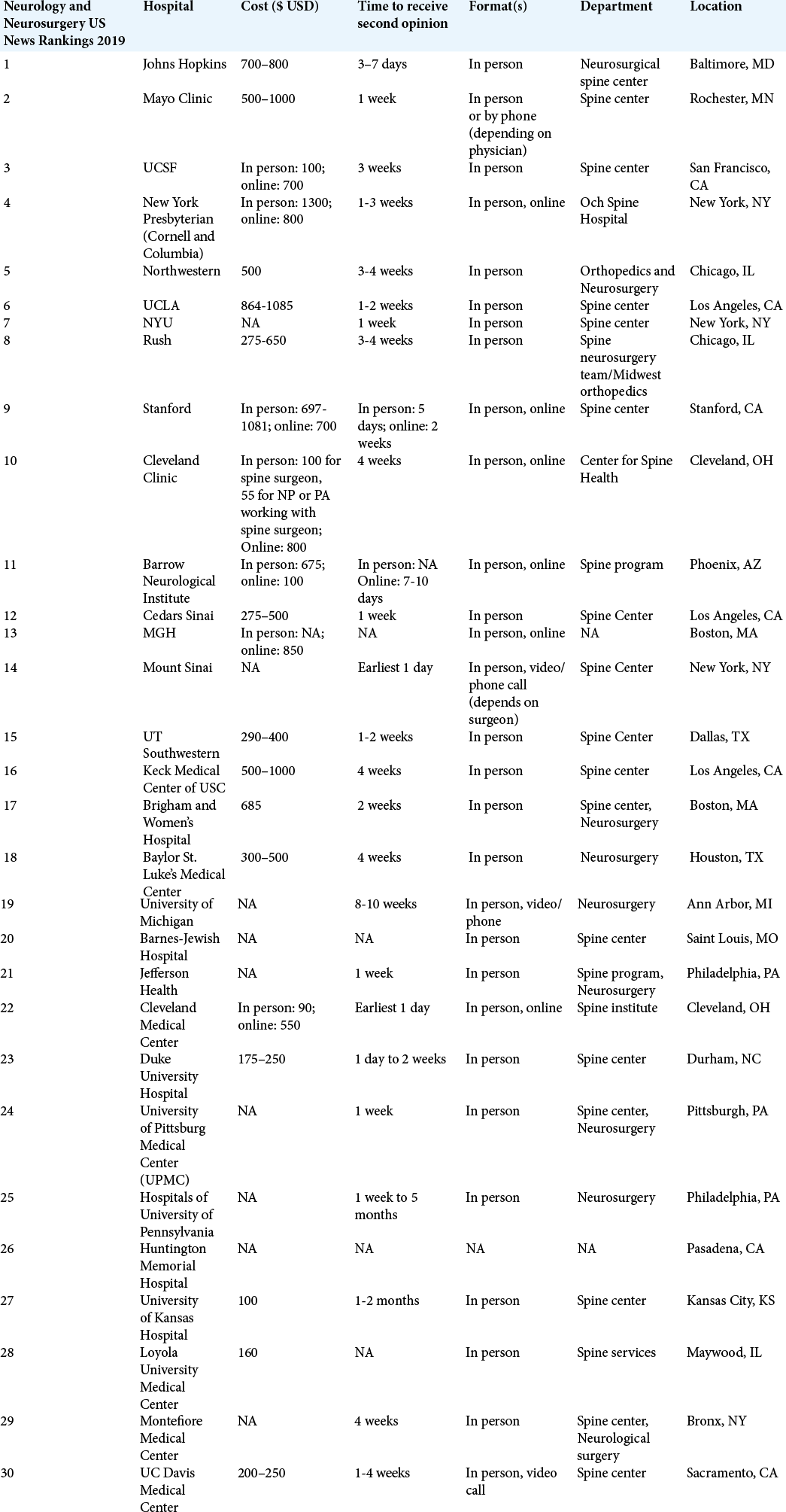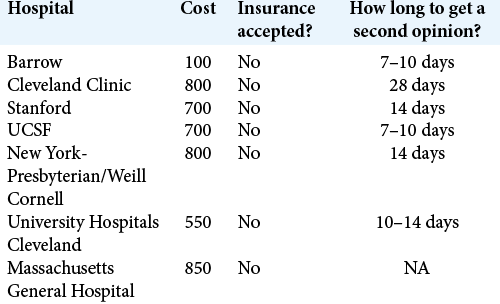- Department of Neurological Surgery, Irvine Medical Center, San Diego, La Jolla, CA, United States.
- Department of Electrical Engineering and Computer Science, San Diego, La Jolla, CA, United States.
- Medical Scientist Training Program, University of California, Irvine, San Diego, La Jolla, CA, United States.
- Department of Neurological Surgery, University of California, San Diego, La Jolla, CA, United States.
DOI:10.25259/SNI_577_2020
Copyright: © 2020 Surgical Neurology International This is an open-access article distributed under the terms of the Creative Commons Attribution-Non Commercial-Share Alike 4.0 License, which allows others to remix, tweak, and build upon the work non-commercially, as long as the author is credited and the new creations are licensed under the identical terms.How to cite this article: Brian V. Lien1, Nolan J. Brown1, Sandra Gattas1,2,3, Elliot H. Choi1, Ronald Sahyouni4, Jessica K. Campos1, Angie Zhang1, Michael Y. Oh1. The market landscape of online second opinion services for spine surgery. 29-Oct-2020;11:365
How to cite this URL: Brian V. Lien1, Nolan J. Brown1, Sandra Gattas1,2,3, Elliot H. Choi1, Ronald Sahyouni4, Jessica K. Campos1, Angie Zhang1, Michael Y. Oh1. The market landscape of online second opinion services for spine surgery. 29-Oct-2020;11:365. Available from: https://surgicalneurologyint.com/?post_type=surgicalint_articles&p=10357
Abstract
Background: The aim of this study was to identify patient interest in second opinion services online and identify the options patients have in obtaining second opinions from spine surgeons in the United States.
Methods: We utilized Google Trends (i.e., search data since 2010) to ascertain the level of interest in receiving second opinions for spinal surgery. In addition, we contacted the top 30 hospitals for neurology and neurosurgery in the U.S. News rankings by phone to obtain information regarding when/how and at what cost they provide second opinions for spine surgery.
Results: The cost of the second surgical opinions averaged $493 (±$343) USD (range $90–$1,300); the time to receive a second opinion averaged 20 (±19) days (range 1 day–5 months). Remote or “online second opinion” programs charged an average of $643 (±$259) USD (range $100–$850), and the time to receive an “online second opinion” averaged 14 (±7) days (range 1–4 weeks).
Conclusion: Although second opinions have been shown to be beneficial to patients, ambiguous or high costs and long wait times may serve as barriers for certain groups (i.e., uninsured or underinsured) and potentially diminish the quality of care.
Keywords: Online second opinion, Second opinion, Spine surgery
INTRODUCTION
Second medical opinions may provide patients with a better understanding of their medical condition and empower them to make informed decisions about their health, particularly with respect to surgical treatments.[
Notably, the literature suggests that the majority of patients find that second opinions are beneficial.[
MATERIALS AND METHODS
Analysis using Google Trends
We used the Google Trends database to ascertain the level of interest in receiving second medical opinions for spinal disorders over time. Using the broad search term “second medical opinion,” we received search data in the United States from the last decade; data were normalized by all searches on Google for a given period of time and presented as a “relative interest” value from 0 to 100 (trends.google. com). We also performed significance testing using t-test for slope of the regression line with an alpha of 0.05 as the significance threshold.
Analysis of top 30 hospitals – 2019 Neurology and Neurosurgery US News Rankings
The top 30 hospitals from the 2019 Neurology and Neurosurgery US News Rankings were contacted by phone to obtain information about second opinion services for spine surgery in February 2020. We asked: (1) how much does a second opinion consultation cost patients? (2) How long does it take to be seen for a second opinion? (3) Are appointments available in-person, over the phone, or over video call? Is there an “online” second opinion program? and (4) On average, how long does it take to be seen?
Definition of online or remote second opinion programs
Online or remote second opinion programs were defined as programs that allow patients to send in medical records and imaging, which are then reviewed by a spine surgeon who provides a second medical opinion. We distinguished “online second opinions,” which are typically out-of-pocket services, from in-person, over the phone, or video call consultations with spine surgeons. Data regarding cost, and time to receive an “online second opinion” (e.g., after submitting records and imaging), were obtained from the programs’ websites, or the programs were contacted directly. All data are presented as mean (±standard deviation).
Definition of wait time and costs for second opinions
We defined “wait time” as the time a patient would need to wait before receiving a second opinion. Costs and wait times for second opinion consultations and “online second opinions” were provided by some institutions as a range. Therefore, to estimate means and standard deviations, the midpoint was obtained as necessary to calculate an approximate or estimated mean and standard deviation.
RESULTS
Internet Google Trends results
We queried internet data from Google Trends using the term “second medical opinion” (2010–2020: United States). Search interest values per month were averaged for each year between 2010 and 2019 [
Figure 1:
Relative interest in second medical opinions as a function of year. Blue trace denotes smoothed Google Trends data using a moving average window size of 12 months and a step size of 1 month. Red line denotes a best linear fit. The regression coefficient is 0.2499. Significance testing using t-test for slope revealed a significant positive trend of second opinion interest rate, growing at rate of 0.249 units per month (P < 0.0001, t = 21.5201).
Analysis of top 30 hospitals – 2019 Neurology and Neurosurgery US News Rankings
For the 30 medical centers in 13 states included in the study, our response rate was 100%; all centers called answered at least one question in the survey [
Estimated cost of second opinions
The estimated mean cost of a second opinion consultation was $493 (±$343) (range $90–$1,300 USD) [
Online second spinal opinions versus in-person/phone/ video call second opinions
In contrast to an in-person or phone/video call second opinion consultation, “online second opinion” programs, whereby spine surgeons review patient imaging and provide a second opinion remotely for an out-of-pocket fee, were also identified. They were available at ~23% (7/30) of medical centers surveyed [
DISCUSSION
Analysis of Google search Trends demonstrated statistically significant increases in relative interest utilizing the search term “second medical opinion” over the last decade. This may reflect an increased interest from patients for these types of services. From our survey of the top hospitals ranked by Neurology and Neurosurgery US News Rankings, we found considerable variability with respect to the cost of standard second opinion consultations, and “online second opinion” services, along with marked differences in the wait times to receive second opinions.
Compromised quality with increased costs and delays for second spinal surgical opinions
The cost and time it takes for a patient in the United States to receive a second opinion for a spinal disorder are important considerations when considering patient access to quality care. For instance, if it takes a long period of time for a patient to see a spine surgeon for a second opinion, a patient with severe and/or disabling pain may choose to forgo the second opinion if they were initially told to undergo surgery. Of note, we did not consider the average time it would take a patient to schedule requisite spine surgery, which could significantly delay surgery even further. Moreover, delays, increased costs (e.g., travel expenses and increased uncovered costs), and the major differences in second surgical options must be factored into the equation of “quality of care.”[
Benefit of online/remote second spinal surgical opinions
The potential benefit of online or remote second opinion programs is obtaining a second opinion without the need to travel. Indeed, the COVID-19 pandemic and the increased need for physical distancing have made online second opinions a more appealing option. Although the majority of online programs provided a written report within 2 weeks, only a subset of patients can afford the cost (e.g., average cost ~$643 [±$259], range $100–$850 USD). This was more expensive than the average cost of a standard in-person second opinion consultation (~$493). Notably, although “online second opinion” programs were more expensive, the estimated average wait times for opinion were ~14 (±7) days; this was lower versus standard in-person second opinion consultations (i.e., 20 (±19) days). Further, none of the “online second opinion” programs took insurance, thus requiring out-of-pocket payments.
Analysis of cost of second spinal surgical opinions
For most patients, costs are covered by insurance companies, and copays vary depending on an individual’s insurance plan. However, approximately 28 million Americans are uninsured; therefore out-of-pocket costs are very relevant.[
Subset of institutions providing online second spinal surgical opinions (Medical Records, Images Alone)
Seven major academic medical centers provided “online second opinion” services at an average cost of $643 USD [
Issues of equal access to second spinal surgical opinions
From a health equity perspective, second opinions should be accessible to all patients to maximize quality of care. However, patients with lower education levels and lower socioeconomic status are less likely to seek second opinions.[
Other arguments for second opinion services
In the future, spine practices and medical centers could take actionable steps to provide greater accessibility to second opinion spinal surgery services, in an effort to standardize the quality of spinal surgical care and improve patient satisfaction.[
CONCLUSION
There is a paucity of published literature regarding the availability, quality, cost, and efficacy of second opinion spinal services, which exist in a variety of formats, such as traditional in-person consultations to phone or video call consultations to written second opinions from online programs. Costs and time to receive a second opinion vary widely, and these variables may serve as barriers for patients seeking second opinions, depending on a patient’s geography and socioeconomic status.
Declaration of patient consent
Patient’s consent not required as patients identity is not disclosed or compromised.
Financial support and sponsorship
Nil.
Conflicts of interest
There are no conflicts of interest.
Acknowledgments
Brian V. Lien and Nolan J. Brown contributed equally.
References
1. Benbassat J. Obtaining a second opinion is a neglected source of health care inequalities. Isr J Health Policy Res. 2019. 8: 12
2. Epstein NE. Are recommended spine operations either unnecessary or too complex? Evidence from second opinions. Surg Neurol Int. 2013. 4: S353-8
3. Gamache FW. The value of another opinion for spinal surgery: A prospective 14-month study of one surgeon’s experience. Surg Neurol Int. 2012. 3: S350-4
4. Lubelski D, Williams SK, O’Rourke C, Obuchowski NA, Wang JC, Steinmetz MP. Differences in the surgical treatment of lower back pain among Spine surgeons in the United States. Spine (Phila Pa 1976). 2016. 41: 978-86
5. Meyer AN, Singh H, Graber ML. Evaluation of outcomes from a national patient-initiated second-opinion program. Am J Med. 2015. 128: 1138.e25-33
6. Okamoto S, Kawahara K, Okawa A, Tanaka Y. Values and risks of second opinion in Japan’s universal health-care system. Health Expect. 2015. 18: 826-38
7. Vialle E. Second opinion in spine surgery: A Brazilian perspective. Eur J Orthop Surg Traumatol. 2015. 25: S3-6
8. Woolhandler S, Himmelstein DU. The relationship of health insurance and mortality: Is lack of insurance deadly?. Ann Intern Med. 2017. 167: 424-31


